Regulation Pickleball Court Dimensions
A regulation pickleball court measures 20 feet wide and 44 feet long, maintaining a uniform size for both singles and doubles play. These dimensions ensure that the court provides enough space for engaging rallies while facilitating quick footwork, allowing for a dynamic gameplay environment.
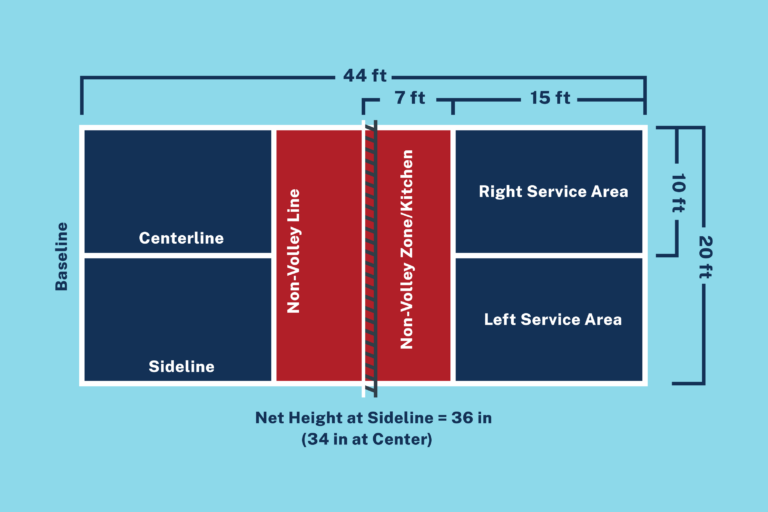
The official dimensions also include key sections vital for gameplay:
- Non-Volley Zone: Extending 7 feet from the net on both sides.
- Service Areas: Positioned behind the non-volley zone, each service area is 10 feet wide and 15 feet deep.
Understanding these dimensions is crucial for proper court setup, as it impacts not only player safety but also the overall integrity of the game. Measurements must be adhered to strictly to promote uniformity in play and efficiently manage court space. This knowledge is essential for players when practicing or competing, ensuring that they adapt their strategies according to the physical space they have available.
Overall Court Size
For pickleball courts, the total playing area is approximately 880 square feet or about 81.7 square meters, ensuring enough room for players to execute their moves without obstruction. Beyond mere width and length, several important factors should be mentioned to properly configure the court:
- Minimum Clearances: A minimum of 10 feet of clearance beyond the backlines and 5 feet on the sides is recommended for safe play.
- Surface Area: The recommended area for optimal play, including safe movement, is approximately 34 feet by 64 feet.
This added space is crucial for accommodating players' movement, especially during intense rallies, and it minimizes risks associated with running into solid objects. Moreover, consistent court dimensions allow players from different courts to compete fairly, creating a standard measure for regulations both locally and in official settings.
Net Specifications
The net is another critical element of a pickleball court, serving as the central point around which much of the game's action revolves. As per regulation, the net must span a minimum length of 21 feet 9 inches, with height specifications as follows:
- Height: 36 inches at the sidelines and 34 inches at the center.
- Material: Constructed from durable mesh fabric to prevent the ball from passing through inadvertently.
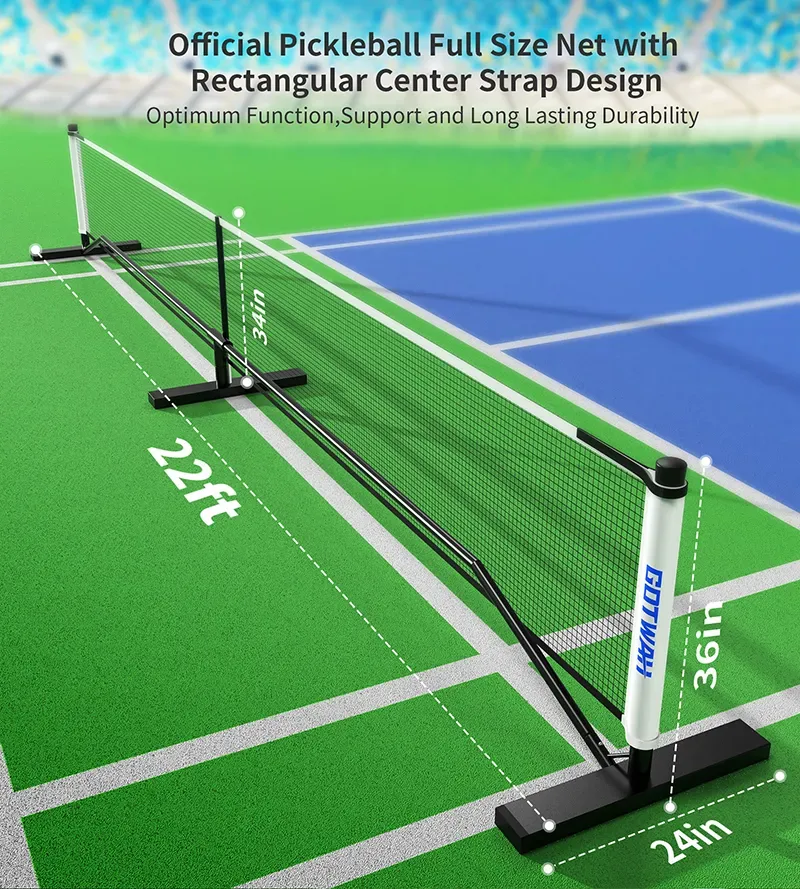
The net should be weighted adequately to remain taut throughout gameplay and positioned with posts placed 12 inches outside the sidelines. These specifications are vital for maintaining fair play and consistent ball bounce, allowing players to analyze their shots effectively and challenge their opponents.
The net's specifications are important not only for executing serves correctly but also for strategizing during gameplay, particularly in terms of when to apply higher shots versus volleys. Additionally, understanding net dynamics can enhance a player’s tactical approach to returning serves.
The Non-Volley Zone (Kitchen)
The non-volley zone, often referred to as the kitchen, is a pivotal aspect of pickleball court design, extending 7 feet from the net on both sides. Players standing inside this area are barred from volleying the ball, creating a strategic depth that is unique to the game and promoting engagement in longer rallies.
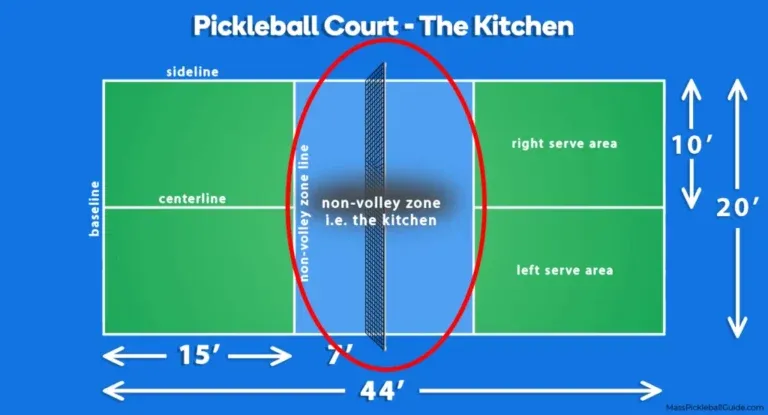
- Definition: The kitchen not only provides a physical space restriction but also adds a psychological layer to gameplay, encouraging players to place their shots thoughtfully.
- Strategic Implications: Players must be mindful of their positioning, ensuring they do not step into the kitchen while attempting a volley. This restriction forces players to think critically about how and when they approach the net, leading to more strategic play and often resulting in longer exchanges.
Additionally, understanding the kitchen zones allows players to build nuanced strategies, utilizing drop shots and placement to draw opponents in while maintaining control over the rally. Familiarity with these dimensions creates better competitive balance and encourages creative game styles.
Service Areas
In pickleball, the designated service areas play a crucial role in defining gameplay. Each side of the court contains service areas that measure 10 feet wide and 15 feet deep, which are integral for initiating play and following the game’s serve rules.
- Centerline: This serves as a divider between the right and left service areas, requiring players to serve diagonally.
- Post-Serve Requirements: Players must ensure the ball clears the non-volley zone after the serve, establishing a critical tactical element when determining shot placement during service attempts.
Understanding these dimensions brings clarity to the technical aspects of serving. Players can fine-tune their techniques knowing the precise area they need to target, optimizing each serve for better strategic advantage.
Court Lines
Court lines are fundamental to defining court boundaries and play areas in pickleball. Each line is typically about 2 inches wide, designed to contrast vividly against the surface for clear visibility. They include:
- Baselines: These lines mark the back boundary of the court.
- Sidelines: They define the lateral limits of the court.
- Centerline: Splitting the service areas into two equal halves.
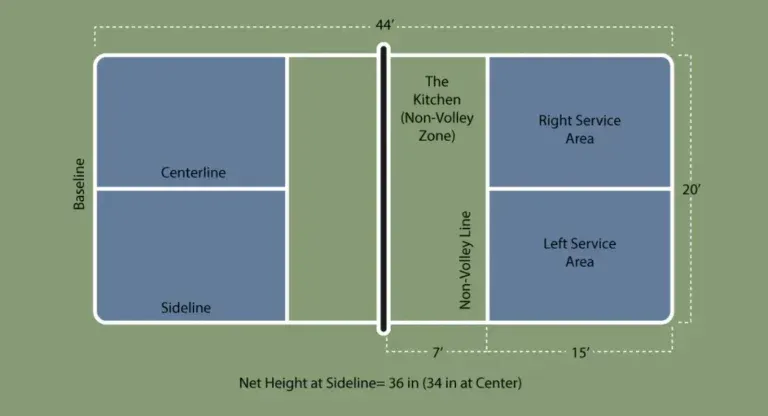
Precision in marking these lines is critical for gameplay integrity. Properly defined lines ensure players maintain adherence to court rules while allowing for unambiguous play. Courts with visible and clear lines support better performance and prevent disputes.
Understanding the Basics of a Pickleball Court
A pickleball court is specifically designed to cater to the dynamics of the sport while ensuring safety for players. One of its most essential f eatures is its standardized size, which plays a significant role in how the game is played. The dimensions are tailored to balance offense and defense, fostering quick reflexes and strategic thinking. Whether you're an experienced player or just starting, familiarity with these dimensions will enhance your playing experience and help you appreciate the tactical aspects of the game more deeply.
Pickleball vs. Other Court Sports
When comparing pickleball to other court sports like tennis and badminton, several differences in dimensions and layout arise that significantly impact gameplay.
| Sport | Court Dimensions (Width x Length) | Comments |
|---|---|---|
| Pickleball | 20 feet x 44 feet (6.1 m x 13.4 m) | Similar dimensions for singles and doubles play. |
| Tennis | 27 feet x 78 feet (single) / 36 feet x 78 feet (double) | Wider and longer than pickleball courts; varies for singles and doubles. |
| Badminton | 20 feet x 44 feet for doubles; 17 feet for singles | Similar length to pickleball but narrower for singles play. |
In a pickleball court, the non-volley zone (kitchen) is a defining characteristic. This area, extending 7 feet from the net, restricts players from volleying the ball while standing within it. This promotes strategic gameplay and requires players to think critically about their positioning relative to the net. On the other hand, [tennis courts](https://picklenlife.com/blogs/pickleball-court-vs-tennis-court/) have a much larger aerial space and game dynamics that allow for more extensive volleying, affecting player strategy significantly.
The vibrant and fast-paced nature of pickleball can attract players who may seek a less physically demanding alternative to tennis, making it accessible for a broader demographic. For those unfamiliar with the dimensions, adaptation to standard layout can be challenging. Understanding these differences helps players strategize better during matches and enhances court utilization for recreational or competitive play.
Choosing the Right Surface Material
Selecting the right surface material for your pickleball court can significantly enhance gameplay and extend the durability of the court. Various options exist, each with unique advantages and characteristics.
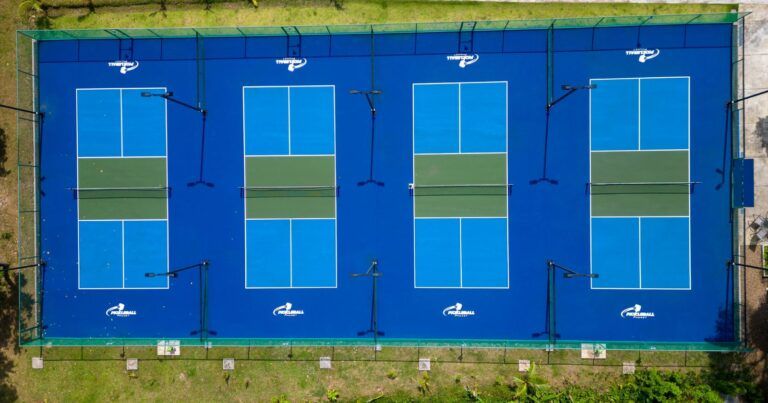
Concrete and Asphalt
Concrete and asphalt are the most common surface materials for pickleball courts, making them widely desirable across recreational and competitive settings.
- Concrete:
- Pros: Highly durable and requires less frequent maintenance, which is beneficial for long-term usage. It also provides a consistent playing surface that enhances ball bounce reliability.
- Cons: Initially, concrete incurs higher installation costs, and its hardness can lead to increased joint strain on players, particularly those with existing conditions.
- Asphalt:
- Pros: Asphalt provides a smoother playing area, contributes to better ball bounce, and is generally a cost-effective option with quick installation process.
- Cons: Asphalt surfaces require regular maintenance to prevent cracking and degradation from weather exposure, thus may incur higher long-term costs.
When weighing these options, budget constraints, maintenance capabilities, and player comfort should all factor into the decision-making process. Each surface type has its own lifespan and care instructions that can significantly affect gameplay quality.
Acrylic Coatings
Acrylic coatings serve as an excellent choice for enhancing pickleball courts, primarily due to their versatility and performance capabilities. They are specifically formulated to endure varying weather conditions and prolong the lifespan of the playing surface.
- Benefits:
- Acrylic coatings provide UV resistance, which helps maintain vibrant color over time.
- They can be customized to affect the speed of play, allowing for tailored gameplay experiences that cater to various skill levels.
- Maintenance:
- Application: Acrylic coatings can be easily applied and require less upkeep than some other surface types. Regular maintenance typically involves cleaning and resurfacing to address any wear, which usually occurs every four to eight years.
Choosing to add acrylic coatings can contribute to the visual appeal and functional integrity of your pickleball court, making it suitable for competitive play while ensuring enjoyable experiences for all players involved.
Polyurethane
Polyurethane surfaces have gained traction, particularly in high-traffic venues, due to their robust design and slip-resistant properties.
- Advantages:
- Polyurethane surfaces can withstand heavy usage while maintaining their structure, making them particularly suited for frequently played courts.
- Their durability across temperature fluctuations means fewer repairs and replacements in the long run.
- Maintenance:
- Care is essential to ensure surface integrity. More regular maintenance compared to acrylic is usually needed to maintain the performance characteristics, but the benefits of improved player safety make it worthwhile.
Understanding these varied surface materials and their maintenance requirements ensures players enjoy a top-notch playing environment while minimizing injuries.
Modular Court Tiles
Modular court tiles have also increased in popularity among pickleball court options due to their advantageous properties and installation ease.
- Materials:Constructed from high-quality polypropylene, these tiles offer a durable yet cushioned surface that promotes safety during play.
- Installation: Interlocking designs allow for straightforward setup, meaning accommodating different layouts can be done quickly.
- Customizability: Players can choose from a variety of colors and drainage options to fit specific needs and aesthetics.
Cushioned Surfaces
Cushioned surfaces are particularly beneficial for players who may experience joint fatigue or those recovering from injury.
- Benefits: They absorb impact effectively, reducing strain on players' joints during play, thus extending how long players can comfortably engage in the game
- Examples: Products like PickleGrip enhance players' comfort levels. Such surfaces may require specific cleaning and maintenance methods to prevent wear.
Accommodating various surfaces allows for differences in play capabilities while ensuring comfort for players of all levels.
Optimizing Court Orientation and Layout
Optimum court layout and orientation can significantly enhance the playing experience while reducing disruptions from environmental factors like solar glare and wind.
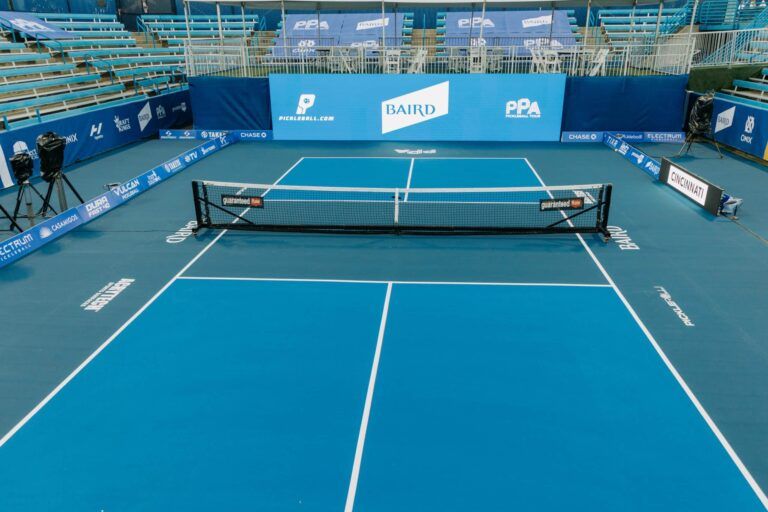
Avoiding Sun Glare
Sun glare can be particularly disorienting for players during sunny matches. To minimize glare:
- Orientation: Courts positioned North-South reduce direct sunlight interference during play, allowing for excellent visibility whether in the morning or evening.
- High Trees/Buffers: Establishing trees or barriers can block direct sunlight and help players stay focused on the game.
Understanding the best layout to avoid sun glare ensures enjoyable outdoor play experiences.
Wind Considerations
Wind can disrupt gameplay, impacting serve stability and making rallies unpredictable. Here are strategies for mitigating wind effects:
- Site Selection: Select locations that naturally shield the court from strong gusts, such as fenced areas, woodlands, or landscaped sections.
- Windscreens: Installing windbreaks can minimize disturbances, helping maintain consistent shot quality while providing an aura of privacy for players.
Factoring in these wind considerations will create an optimal playing environment for all participants involved.
Lighting Your Pickleball Court for Evening Play
Adequate lighting is essential for players looking to enjoy pickleball during twilight hours or evenings.
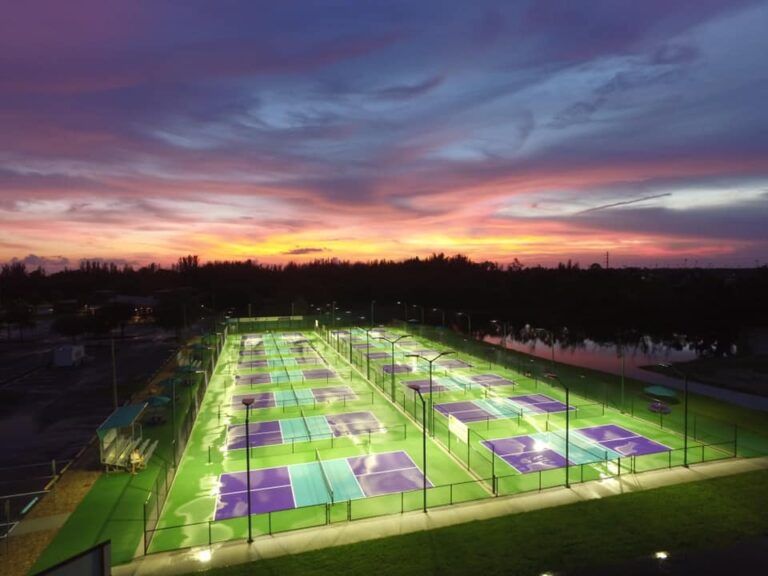
LED Lighting Options
The use of LED lighting can greatly enhance visibility on the court, making evening gameplay more enjoyable and comfortable.
- Benefits: LED lights are energy-efficient and generally provide a bright, uniform light that increases safety and visibility while reducing power costs.
- Placement: Lights should be positioned strategically around the court to minimize dark spots and ensure entire playing areas are illuminated.
Consideration of lighting types and placement can influence how effectively players utilize the court during evening play.
Minimizing Light Pollution
As urban areas become denser, consideration for light pollution becomes increasingly pertinent. Strategies to minimize light pollution in pickleball court lighting include:
- Shielding: Using fixtures designed to prevent light spillover into residential areas ensures neighborly relationships are maintained.
- Placement of Fixtures: Properly locating floodlights to direct light towards the playing surface while avoiding excessive upward dispersal reduces environmental impact.
By implementing these strategies, the lighting installation can be both player-friendly and environment-conscious.
Converting Existing Courts for Pickleball
In many cases, existing courts such as tennis or basketball courts can easily be converted into pickleball courts, optimizing space and facilities within communities.
Converting a Tennis Court
Tennis courts provide a great foundation for pickleball transformation, given that they are larger than necessary for pickleball setups.
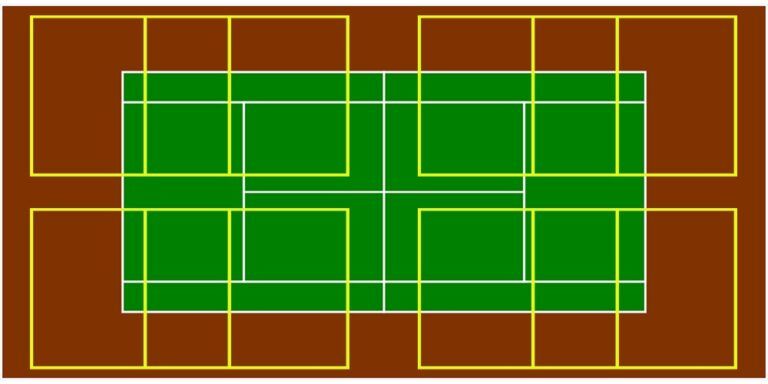
- Layout: The original dimensions of a tennis court (60 feet wide and 120 feet long) allow for multiple pickleball courts within one space.
- Marking: Clear lines need to be marked for each pickleball court, delineating service areas and the non-volley zone.
- Net Adjustment: The net height should be adjusted to 34 inches at the center while ensuring proper tension for gameplay.
Community facilities can benefit immensely from adding pickleball courts through this conversion process, thereby attracting more players to the facility.
Converting Other Surfaces
Beyond tennis courts, converting basketball and badminton courts to accommodate pickleball can further enhance the sport's presence.
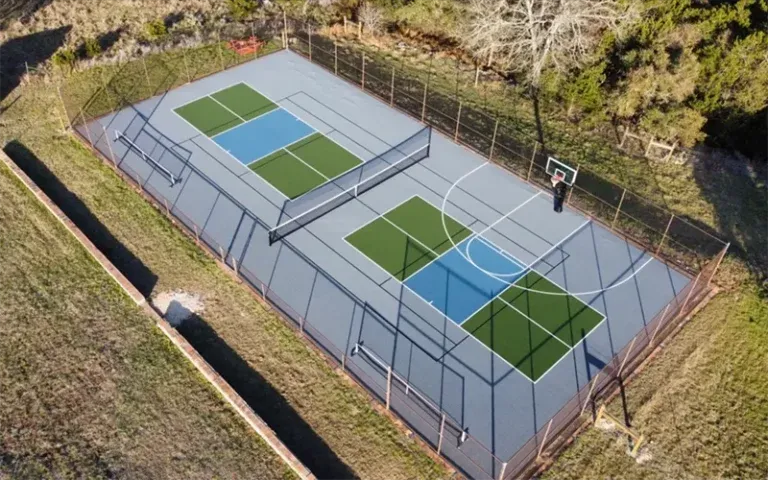
- Basketball Courts:
- Existing basketball courts, typically 60 feet by 30 feet, can host dedicated pickleball areas by including straightforward markings.
- Cleaning the surface before marking is crucial to maintain playability standards.
By understanding how to modify existing courts effectively, communities can enhance recreational opportunities while accommodating the growing popularity of pickleball.
Building a Backyard Pickleball Court
Creating a backyard pickleball court is a fulfilling endeavor that allows for private play and fun gatherings with family and friends. Understanding specific requirements makes the process easier.
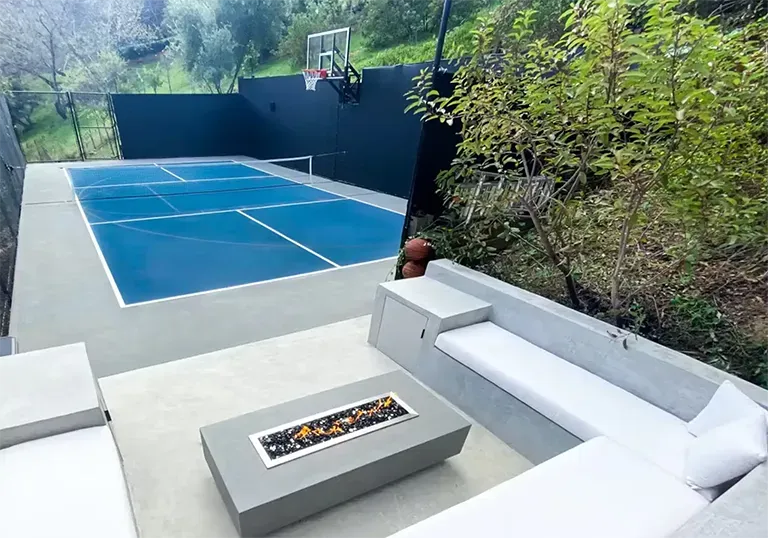
Space Requirements
When constructing a backyard pickleball court, it’s essential to consider the layout and recommended dimensions:
- Standard: A regulation court measures 20 feet wide and 44 feet long, but for optimal play, a total area of 30 feet by 60 feet is ideal.
- Safe Clearances: Ensure ample buffer zones of at least 10-12 feet beyond the baselines to facilitate player movement.
Careful measurement and planning will lead to the successful establishment of an effective and enjoyable court space.
Surface Options for Backyard Courts
When choosing the surface for your backyard court, you have several durable materials to consider:
- Concrete: Provides long-term stability but requires an initial investment.
- Asphalt: More budget-friendly and easier to install, although frequent maintenance may be necessary.
- Modular Tile Systems: Versatile and cushioned, allowing for easy installation and customization in appearance.
Selecting the most suitable surface can dramatically affect the enjoyment and longevity of your backyard court; it’s critical to choose according to your budget and intended use.
Marking and Setting Up the Court
Accurate marking on a backyard court is vital for effective play. To set up your court:
- Court Layout: Using a measuring tape, lay out your court dimensions precisely, aligning with recommended specs.
- Marking Lines: Use durable paint or tape for demarcation, ensuring that all lines are at least 2 inches wide for visibility.
- Proper Orientation: Aligning your court to minimize sun glare could greatly enhance the playing experience.
A carefully set up court allows for better gameplay and enhances overall enjoyment, ensuring time spent on the court is productive and fun.
Accessibility and Inclusive Design Considerations
Inclusive design in pickleball court construction ensures all players, including those with disabilities, have equal access and enjoyment.
Wheelchair Accessibility
For players using wheelchairs, specific design aspects must be meticulously planned:
- Dimensions: Courts should be slightly larger than standard dimensions, ideally around 74 feet in length and 44 feet in width, to facilitate ease of movement.
- Smooth Surfaces: Ensure all areas around the court are level and smooth, free of any potential trip hazards.
Implementing features focusing on accessibility allows everyone to enjoy pickleball, thus promoting inclusivity in community sports.
Visual Impairments
Addressing the needs of visually impaired players is critical for inclusive design on pickleball courts.
- High-Contrast Colors: Use colors that stand out distinctly against the court surface for lines and markings.
- Tactile Indicators: Consider incorporating tactile markers along court boundaries to assist visually impaired players in navigating the court.
The focus on these elements ensures a welcoming environment where all players can thrive.
Auditory Sensitivities
For individuals with auditory sensitivities, creating quieter play areas is important to reduce disturbances:
- Sound-Absorbing Materials: Implementing materials like acoustic panels can help minimize noise levels during play, enhancing comfort for sensitive individuals.
- Strategic Layout: Plan court location to minimize outside noise disturbances, thereby improving the overall experience for players with sensitivities.
Accommodating players' sensory needs will foster a more inclusive atmosphere, inviting engagement from a wider player base.
Cost Analysis and Budgeting
When constructing a pickleball court, understanding the financial implications is vital for effective budgeting and planning.
Surfacing Material Costs
The material chosen for the court surfaces can significantly influence both initial expenses and long-term maintenance needs:
- Asphalt: Costs range from $4,000 to $6,000 for basic installation; however, regular repairs may be needed, potentially increasing lifetime costs.
- Concrete: Installation prices can range from $6,000 to $10,000, but its durability means lower maintenance expenses over the years.
- Acrylic Coatings: Installation and finishing can range between $5,000 to $15,000, depending on the desired level of cushioning and performance enhancements.
Budgeting wisely and understanding the trade-offs of different materials will facilitate the most effective planning for your court’s construction.
Lighting and Fencing Costs
Proper lighting and fencing options must be considered as part of the overall budget, as they dramatically enhance functionality:
- LED Lighting: Basic installations can start around $2,500, while comprehensive setups for tournaments may cost upwards of $12,500.
- Fencing: Chain-link fencing can cost between $15 and $25 per linear foot, so constructing a complete perimeter fence will vary widely based on dimensions.
Incorporating these elements within the budget will allow for comprehensive planning for safety and operational integrity.
Additional Amenities
Considering additional amenities will add to the overall functionality and comfort of your pickleball court setup:
- Seating: Costs for benches usually range from $200 to $400, depending on materials chosen.
- Shade Structures: Structures can range significantly in terms of installation costs and design; planning for these will improve the overall court experience.
Incorporating these amenities not only enhances player satisfaction but also promotes community engagement and usage.
Maintenance and Repair Tips
Proper maintenance is essential for extending the life of your pickleball court and enhancing player safety.
Cleaning and Upkeep
Regular cleaning practices are essential to keep the court in excellent condition:
- Daily Maintenance: Sweeping leaves and debris prevents dirt build-up which can affect gameplay.
- Washing: Monthly washing with a mild detergent keeps the surface clean without damaging material integrity.
Understanding and implementing a consistent maintenance routine will ensure long-lasting performance of the court.
Repairing Cracks and Damage
Being proactive about minor repairs can save money and maintain quality:
- Inspection: Regularly check for cracks or other damages. Small cracks can typically be addressed with acrylic crack fillers or concrete fillers.
- Professional Help: For significant issues, professional resurfacing may be necessary, particularly for asphalt courts.
By remaining diligent with court upkeep, players can ensure optimal playing conditions that enhance both safety and enjoyment.
Conclusion
Creating a pickleball court, whether through conversion from an existing facility or installation in a backyard, requires an informed approach to dimensions, materials, and maintenance. By understanding the distinct characteristics of court setups ranging from the non-volley zone to line definitions players can cultivate a space that includes engaging gameplay and optimal conditions for all skill levels. Attention to element specifics, such as lighting and surface choices, allows for capacity to adapt based on player needs and community engagement. With effective planning, the joy of pickleball can be seamlessly interwoven into local recreation spaces, facilitating health and connection through dynamic play experiences. Ultimately, the commitment to proper guidelines will result in vibrant pickleball courts that serve as hubs of activity, fostering enthusiasm for the sport within the community.










